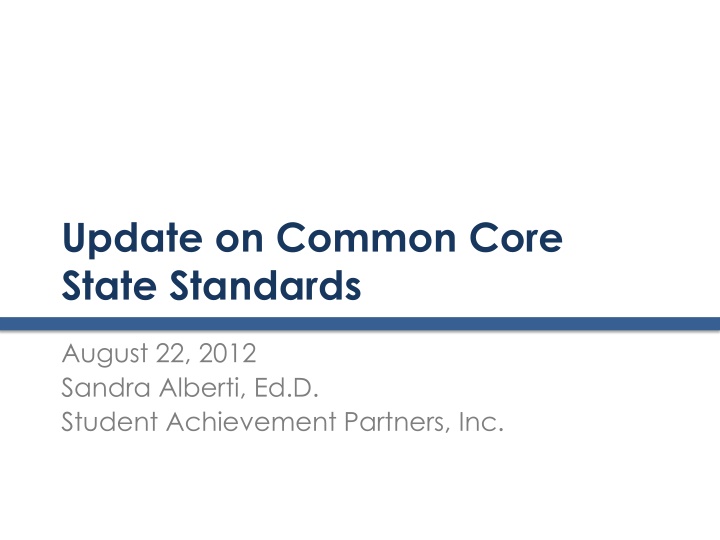
Update on Common Core State Standards
Explore the significant changes and rationale behind the Common Core State Standards, focusing on English Language Arts, literacy, and mathematics. Learn about the principles guiding the standards and the shift towards content-rich nonfiction in education.
Download Presentation

Please find below an Image/Link to download the presentation.
The content on the website is provided AS IS for your information and personal use only. It may not be sold, licensed, or shared on other websites without obtaining consent from the author. If you encounter any issues during the download, it is possible that the publisher has removed the file from their server.
You are allowed to download the files provided on this website for personal or commercial use, subject to the condition that they are used lawfully. All files are the property of their respective owners.
The content on the website is provided AS IS for your information and personal use only. It may not be sold, licensed, or shared on other websites without obtaining consent from the author.
E N D
Presentation Transcript
Update on Common Core State Standards August 22, 2012 Sandra Alberti, Ed.D. Student Achievement Partners, Inc.
Agenda for the day Background on the Common Core State Standards Initiative English Language Arts and Literacy Standards Major Shifts Rationale Implications for teacher preparation Mathematics Standards Major Shifts Rationale Implications for teacher preparation Overview of Consortia Assessments and Other Implications www.achievethecore.org 2
Rationale for the CCSS Declining US competitiveness with other developed countries High rates of college remediation NAEP performance that is largely flat over the past 40 years in 8th grade Slight improvement at the 4th grade level Slight decline at the high school level www.achievethecore.org
Principles of the CCSS Fewer - Clearer - Higher Aligned to requirements for college and career readiness Based on evidence Honest about time www.achievethecore.org
Where we are in CT and around the nation? www.achievethecore.org 5
ELA/Literacy: 3 shifts The What 1. Building knowledge through content-rich nonfiction www.achievethecore.org
The Why: Shift One Building knowledge through content-rich nonfiction Much of our knowledge base comes from informational text Informational text makes up vast majority of required reading in college/workplace (80%) Informational text harder for students to comprehend than narrative text Yet students are asked to read very little of it in elementary (7 - 15%) and middle school CCSS moves percentages to 50:50 at elementary level 75:25 at secondary level (includes ELA, science, social studies) www.achievethecore.org
ELA/Literacy: 3 shifts The What 1. Building knowledge through content-rich nonfiction 2. Reading, writing, and speaking grounded in evidence from text, both literary and informational www.achievethecore.org
The Why: Shift Two Reading, writing & speaking grounded in evidence, both literary and informational Most college and workplace writing is evidence-based and expository in nature (not narrative) Ability to cite evidence differentiates student performance on NAEP Standards in writing ask students to respond to evidence- based writing prompts (inform/argue) Standards in speaking and listening require students to prepare for and refer to evidence on ideas under discussion Standards in reading require students to respond to text-dependent questions with evidence-based claims www.achievethecore.org
ELA/Literacy: 3 shifts The What 1. Building knowledge through content-rich nonfiction 2. Reading, writing, and speaking grounded in evidence from text, both literary and informational 3. Regular practice with complex text and its academic language www.achievethecore.org
The Why: Shift Three Regular Practice with Complex Text and its Academic Language Gap between complexity of college and high school texts is huge What students can read, in terms of complexity is greatest predictor of success in college (ACT study) Too many students reading at too low a level (<50% of graduates can read sufficiently complex texts) Standards include a staircase of increasing text complexity from elementary through high school Standards also focus on building vocabulary that is shared across many types of complex texts and many content areas www.achievethecore.org
Mathematics: 3 shifts The What 1. Focus: Focus strongly where the standards focus. www.achievethecore.org
The Why: Shift One Focus strongly where the Standards focus Significantly narrow the scope of content and deepen how time and energy is spent in the math classroom Focus deeply only on what is emphasized in the standards, so that students gain strong foundations www.achievethecore.org
Traditional U.S. Approach K 12 Number and Operations Measurement and Geometry Algebra and Functions Statistics and Probability www.achievethecore.org
Focusing attention within Number and Operations Expressions and Equations Operations and Algebraic Thinking Number and Operations Base Ten Algebra The Number System Number and Operations Fractions K 1 2 3 4 5 6 7 8 High School www.achievethecore.org
Mathematics: 3 shifts The What 1. Focus: Focus strongly where the standards focus. 2. Coherence: Think across grades, and link to major topics www.achievethecore.org
The Why: Shift Two Coherence Think across grades, and link to major topics within grades Carefully connect the learning within and across grades so that students can build new understanding onto foundations built in previous years. Begin to count on solid conceptual understanding of core content and build on it. Each standard is not a new event, but an extension of previous learning. www.achievethecore.org
Coherence: Think across grades Fraction example: The coherence and sequential nature of mathematics dictate the foundational skills that are necessary for the learning of algebra. The most important foundational skill not presently developed appears to be proficiency with fractions (including decimals, percents, and negative fractions). The teaching of fractions must be acknowledged as critically important and improved before an increase in student achievement in algebra can be expected. Final Report of the National Mathematics Advisory Panel (2008, p. 18) www.achievethecore.org
Coherence: Link to major topics within grades Example: data representation Standard 3.MD.3 www.achievethecore.org
Coherence: Link to major topics within grades Example: Geometric measurement 3.MD, third cluster www.achievethecore.org
Mathematics: 3 shifts The What 1. Focus: Focus strongly where the standards focus. 2. Coherence: Think across grades, and link to major topics 3. Rigor: In major topics, pursue conceptual understanding, procedural skill and fluency, and application www.achievethecore.org
The Why: Shift Three Rigor In major topics, pursue conceptual understanding, procedural skill and fluency, and application The CCSSM require a balance of: Solid conceptual understanding Procedural skill and fluency Application of skills in problem solving situations This requires equal intensity in time, activities, and resources in pursuit of all three www.achievethecore.org
Priorities in Mathematics Priorities in Support of Rich Instruction and Expectations of Fluency and Conceptual Understanding Addition and subtraction, measurement using whole number quantities Grade K 2 Multiplication and division of whole numbers and fractions 3 5 Ratios and proportional reasoning; early expressions and equations Ratios and proportional reasoning; arithmetic of rational numbers 6 7 Linear algebra 8
Required Fluencies in K-6 Grade Standard Required Fluency K.OA.5 K Add/subtract within 5 1.OA.6 1 Add/subtract within 10 2.OA.2 Add/subtract within 20 (know single-digit sums from memory) 2 2.NBT.5 Add/subtract within 100 Multiply/divide within 100 (know single-digit products from memory) 3.OA.7 3 3.NBT.2 Add/subtract within 1000 4.NBT.4 4 Add/subtract within 1,000,000 5.NBT.5 5 Multi-digit multiplication Multi-digit division 6.NS.2,3 6 Multi-digit decimal operations www.achievethecore.org
Mathematical Practices 1. Make sense of problems and persevere in solving them. 2. Reason abstractly and quantitatively. 3. Construct viable arguments and critique the reasoning of others. 4. Model with mathematics. 5. Use appropriate tools strategically. 6. Attend to precision. 7. Look for and make use of structure. 8. Look for and express regularity in repeated reasoning. www.achievethecore.org
General Notes about Implementation The CCSS uses an eraser and pen and provides time and space to focus on doing fewer things better Implementation of the CCSS must be integrated into other efforts of educational improvement, not one more thing Commit to a small number of metrics that address Teacher Practice and Knowledge Instructional Materials and Resources Student Work www.achievethecore.org
Resources www.achievethecore.org www.pta.org/4446.htm http://www.cgcs.org/domain/36 http://parcconline.org/parcc-content-frameworks www.Illustrativemathematics.org www.achievethecore.org
Achievethecore.org Twitter handle: @achievethecore www.achievethecore.org 28
PARCCs Fundamental Advance PARCC is designed to reward quality instruction aligned to the Standards, so the assessment is worthy of preparation rather than a distraction from good work. www.achievethecore.org 29
PARCCs Core Commitments to Mathematics Assessment Quality Focus: PARCC assessments will focus strongly on where the Standards focus. Students will have more time to master concepts at a deeper level. Problems worth doing: Multi-step problems, conceptual questions, applications, and substantial procedures will be common, as in an excellent classroom. Better Standards Demand Better Questions: Instead of reusing existing items, PARCC will develop custom items to the Standards. Fidelity to the Standards (now in Teacher s hands): PARCC evidences are rooted in the language of the Standards so that expectations remain the same in both instructional and assessment settings. www.achievethecore.org 30
PARCCs Core Commitments to ELA/Literacy Assessment Quality Texts Worth Reading: The assessments will use authentic texts worthy of study instead of artificially produced or commissioned passages. Questions Worth Answering: Sequences of questions that draw students into deeper encounters with texts will be the norm (as in an excellent classroom), rather than sets of random questions of varying quality. Better Standards Demand Better Questions: Instead of reusing existing items, PARCC will develop custom items to the Standards. Fidelity to the Standards (now in Teachers hands): PARCC evidences are rooted in the language of the Standards so that expectations remain the same in both instructional and assessment settings. www.achievethecore.org 31
Other areas of impact Measures of Teacher Effectiveness Procurement policies Publishers Criteria for ELA/Literacy Publishers Criteria for Mathematics www.achievethecore.org 32

